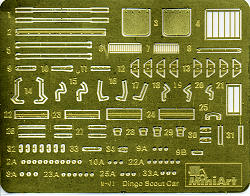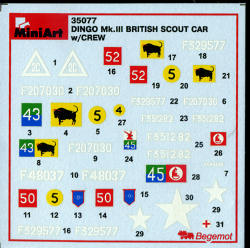
MiniArt 1/35 Dingo Mk III
| KIT #: | 35077 |
| PRICE: | $51.50 SRP - $29.95 from http://www.scale-model-kits.com |
| DECALS: | Four options |
| REVIEWER: | Scott Van Aken |
| NOTES: |

| HISTORY |
In 1938 the British War Office issued a specification for a scouting vehicle. Out of three designs submitted by Alvis, BSA and Morris, the one by BSA was selected. The actual production was passed to Daimler, which was a vehicle manufacturer in the BSA group of companies. The vehicle was officially designated Daimler Scout Car, but became widely known as Dingo, which was the name of the competing Alvis prototype.
Arguably one of the finest armoured fighting vehicles built in Britain during the war, the Dingo was a small two-man armoured car. It was well protected for its size with 30 mm of armour at the front. The engine was located at the rear of the vehicle. One of the ingenious features of Dingo was the transmission; a pre-selector gearbox and fluid flywheel that gave five speeds in both directions. Original version had four-wheel steering; however this feature was dropped in Mk II because inexperienced drivers found the vehicle hard to control.
Although the Dingo featured a flat plate beneath the chassis to slide across uneven ground, it was extremely vulnerable to mines. No spare wheel was carried, but it was not really necessary because of the use of run-flat (nearly solid) rubber tyres instead of pneumatic. Despite the hard tyres, the independent suspension gave it a very comfortable ride. A swiveling seat next to the driver allowed the other crew member to attend to the No. 19 wireless set or Bren gun when required.
The Dingo was first used by the British Expeditionary Force (1st Armoured Division and 4th Northumberland Fusilers) during the Battle of France. It turned out to be so successful that no replacement was sought until 1952 with the production of the Daimler Ferret. In mid-70s the Dingo was still used by Cyprus, Portugal and Sri Lanka.
The Mk III differed from earlier versions by having a waterproofed engine and no roof. The Lynx was basically a Canadian built Dingo.
| THE KIT |
 MiniArt has been gaining a reputation for well engineered and well detailed kits. From the looks of this one, that reputation is well earned. Molded in a grey plastic, the detailing and quality of the mold
MiniArt has been gaining a reputation for well engineered and well detailed kits. From the looks of this one, that reputation is well earned. Molded in a grey plastic, the detailing and quality of the mold ing is first rate. No flash, no sink areas, few ejector marks and those in areas that will be hidden or easily sanded away. The 228 parts are located on 6 sprues and one goodly sized photo etch fret. In fact, many of the really small parts (like bolt heads) are on the photo etch fret. This fret is covered on both sides by a somewhat thick clear plastic film. The etched parts are attached to the fret by a very fine line so do require some cutting to set them free. I think the plastic film is to help keep them in place until actually placed on the kit. This photo etch is also used for hinges, grab handles, screens and the usual fine detail pieces.
ing is first rate. No flash, no sink areas, few ejector marks and those in areas that will be hidden or easily sanded away. The 228 parts are located on 6 sprues and one goodly sized photo etch fret. In fact, many of the really small parts (like bolt heads) are on the photo etch fret. This fret is covered on both sides by a somewhat thick clear plastic film. The etched parts are attached to the fret by a very fine line so do require some cutting to set them free. I think the plastic film is to help keep them in place until actually placed on the kit. This photo etch is also used for hinges, grab handles, screens and the usual fine detail pieces.
There is detail on the inside of most of the hull pieces as well. Hatches are designed to be posed open or closed as one wishes. As this is an open topped vehicle, there is a great deal of interior detail and many of the 50 construction steps are dedicated to fitting this out. As you see in the image, the wheels are plastic and have molded on tires. These are separate from any sprue. The kit includes three crew figures, and is not identical to the separately boxed crew set as only two of the five figures in that set are i ncluded. One of them is the rather intense looking driver, so it appears that MiniArt basically used half of the figure set for this car and half for the Mk Ib.
ncluded. One of them is the rather intense looking driver, so it appears that MiniArt basically used half of the figure set for this car and half for the Mk Ib.
Instructions are well illustrated, and the sheet is quite dense with information and construction steps so one needs to pay close attention to the sequence. There is a separate full color painting and markings sheet with multiple paint references. Four options, all in a base of Dark Green. First up is 11th Armored Division in France, 1944. Second option is P.E.I. Light Horse. This one has black splotches on it. Third is the box art vehicle from the 11th Armored Division. The final option is from 8th Kings Royal Irish Hussars, 7th Armored Division in Holland during late 1944. Decals are well printed and quite colorful.
| CONCLUSIONS |
Once again, a superb kit of an important British military vehicle and one with lots of possibilities for those who like to do 'foreign' military arms.
| REFERENCES |
http://en.wikipedia.org June 2009 Thanks to http://www.scale-model-kits.com for the preview kit. Get yours today from the link at a considerable savings over retail. If you would like your product reviewed fairly and fairly quickly, please contact the editor or see other details in the Note to Contributors.